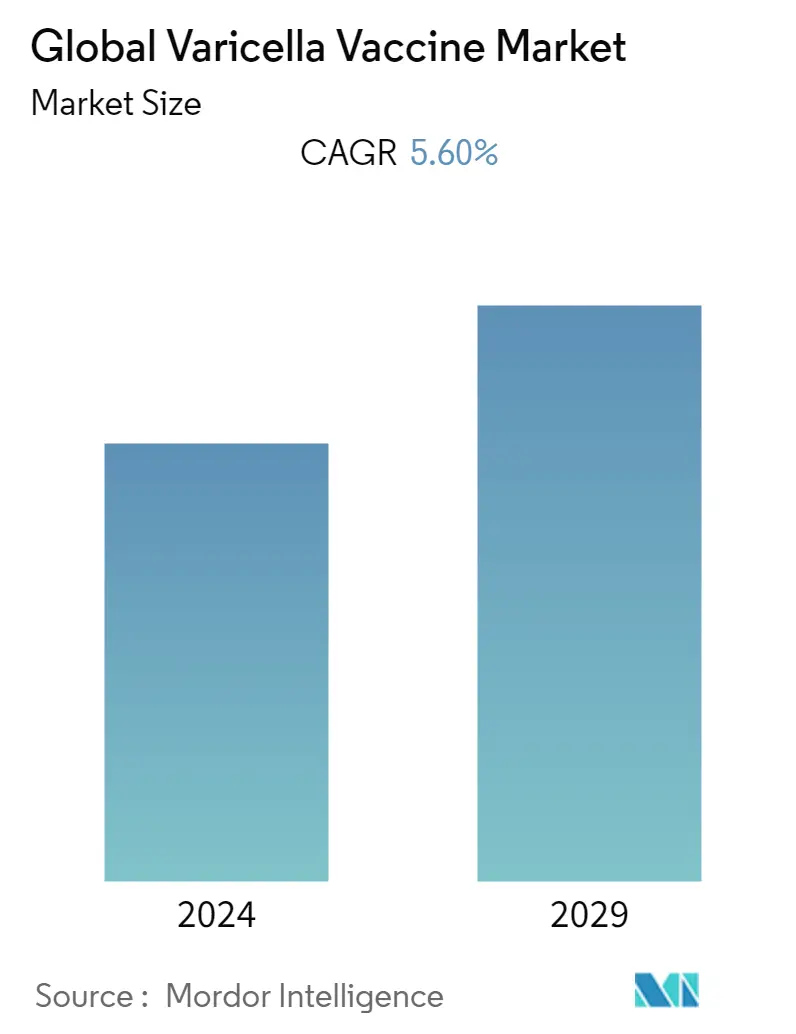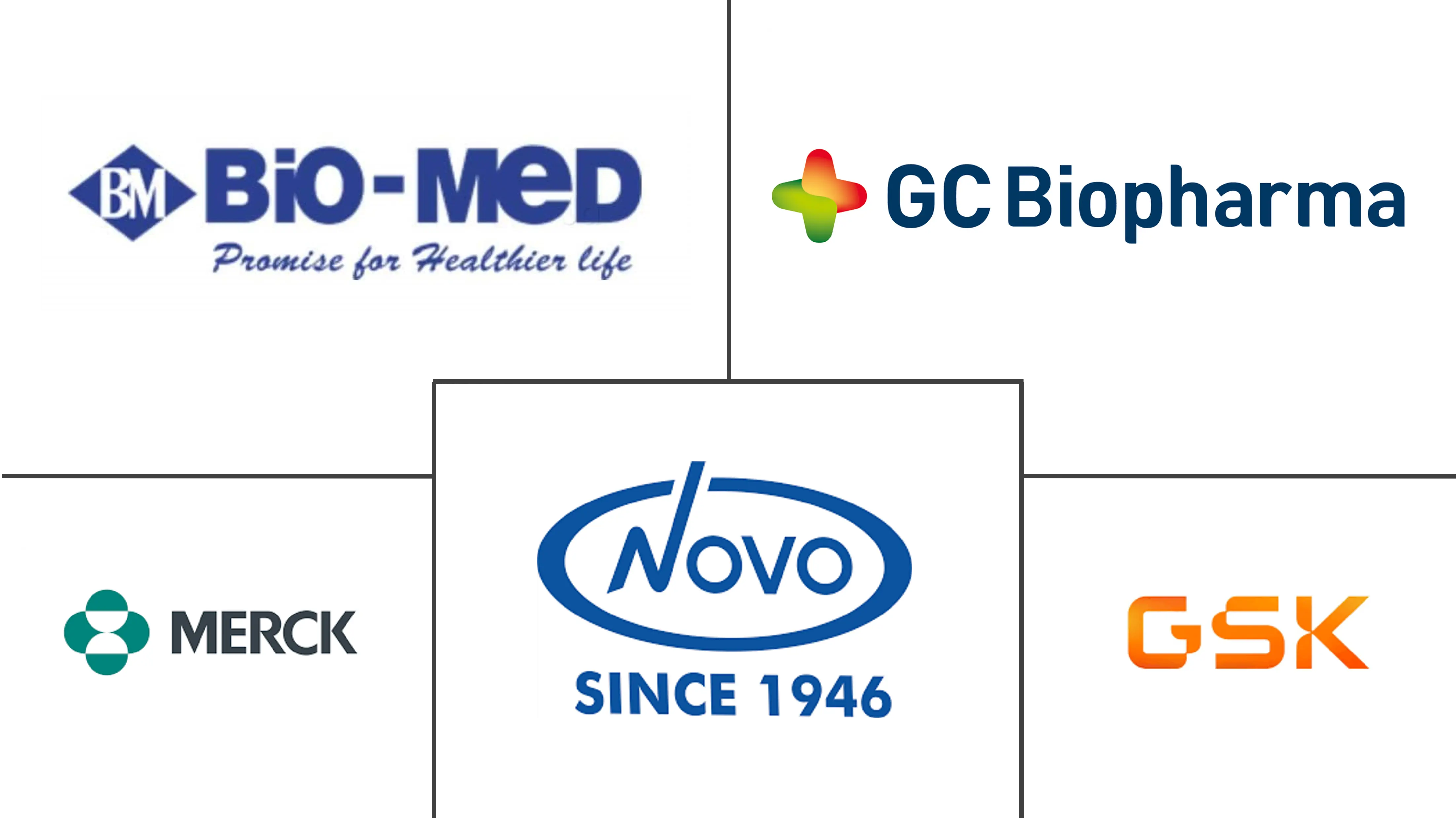Market Size of Global Varicella Vaccine Industry

| Study Period | 2019 - 2029 |
| Base Year For Estimation | 2023 |
| Forecast Data Period | 2024 - 2029 |
| CAGR | 5.60 % |
| Fastest Growing Market | Asia Pacific |
| Largest Market | North America |
Major Players
*Disclaimer: Major Players sorted in no particular order |
Varicella Vaccine Market Analysis
The varicella vaccine market is expected to register a CAGR of 5.6% during the forecast period, 2022-2027.
The acute respiratory syndrome coronavirus 2 (SARS-CoV-2) that causes coronavirus disease has been linked to T-cell immunological dysfunction. Herpes zoster reactivation could be brought on by COVID-19 infection. According to the study titled "Can, COVID-19 Increase the Risk of Herpes Zoster? A Narrative Review" published in the Dermatology and therapy in August 2021, Varicella-zoster virus reactivation on COVID-19 patients can be brought on by T cell dysfunction, such as lymphopenia and lymphocyte depletion. Due to COVID-19's propensity to develop an immunosuppressive state, which is linked to the functional impairment and concurrent quantitative decline in T lymphocytes, particularly CD4+ T cells, CD8+ T cells, and natural killer cells, patients with COVID-19 are more likely to experience reactivation of herpes zoster. Moreover, according to the study titled "Herpes zoster in the era of COVID 19: A prospective observational study to probe the association of herpes zoster with COVID 19 infection and vaccination" published in the National Library of Medicine in June 2022, reported that during post-marketing surveillance, reactivation of the varicella-zoster virus has occasionally been reported following vaccination for SARS-CoV-2. Therefore, during the ongoing COVID-19 outbreak, managing varicella infection has become more crucial.
The market is driven by the rising prevalence of the target diseases, growing awareness regarding the use of the varicella vaccine, and an increase in immunization programs across the world. For Instance, In August 2020, GSK reported the launch of DT campaign for shingrix vaccine targeted against the aging for vaccination against vericella. Similatly, as per the National Health Mission in July 2022, One of the biggest public health initiatives, the Universal Immunization Program (UIP), targets nearly 2.67 billion newborns and 2.9 billion expectant mothers each year against diseases including measles, rubella, chickenpox, and other. Thus, a growing immunization program against the varicella zoster is expected to drive the demand for varicella vaccines thereby boosting the market growth.
However, the growing prevalence of varicella or chickenpox is anticipated to drive the growth of the market. For instance, according to the study titled "Epidemiological analysis of varicella in Dalian from 2009 to 2019 and application of three kinds of the model in prediction prevalence of varicella' published in the BMC Public Health in April 2022, the prevalence was 50.56/100000 on a yearly average. The bimodal distribution of varicella was constant throughout the year. Moreover, according to the Center for Diseases Control and Prevention in May 2021, Herpes zoster affects people 60 and older at a rate of about 1 case per 100 in the U.S. each year, and 1 to 4% of patients end up in hospitals for complications, 30% of whom have weakened immune systems. Elderly people are more prone to herpes zoster due to weakened immune systems. However, the high cost of vaccines restraint the market growth.
Furthermore, growing awareness regarding varicella vaccine usage, active participation of the government in immunization programs, and a surge in the acceptance of varicella vaccines are the key driving factors in the varicella vaccine market. However, high cost of the vaccine restraint the market growth.
Varicella Vaccine Industry Segmentation
As per the scope of the report, varicella or chickenpox is an acute and highly contagious disease caused by the varicella-zoster virus, which is a member of the herpes family. It usually occurs during childhood and is very contagious. The Market is Segmented by Vaccine Type (Monovalent Varicella Vaccine and Combination Varicella Vaccine), Application (Chickenpox Immunization, Herpes Zoster Immunization, Mumps, Measles, Rubella, and Varicella Immunization), and Geography (North America, Europe, Asia-Pacific, Middle-East and Africa, and South America). The market report also covers the estimated market sizes and trends for 17 different countries across major regions globally. The report offers the value (in USD million) for the above segments.
| By Vaccine | |
| Monovalent Varicella Vaccine | |
| Combination Varicella Vaccine |
| By Application | |
| Chickenpox Immunization | |
| Herpes Zoster Immunization | |
| Mumps, Measles, Rubella, and Varicella Immunization |
| Geography | ||||||||
| ||||||||
| ||||||||
| ||||||||
| ||||||||
|
Global Varicella Vaccine Market Size Summary
The varicella vaccine market is poised for significant growth, driven by the increasing prevalence of varicella and herpes zoster, alongside heightened awareness and participation in immunization programs globally. The market is influenced by the ongoing impact of COVID-19, which has been linked to T-cell immunological dysfunctions that may reactivate the varicella-zoster virus, thereby underscoring the importance of managing varicella infections. The introduction of public health initiatives, such as the Universal Immunization Program, aims to combat diseases like chickenpox, further propelling market demand. The monovalent varicella vaccine segment is expected to maintain a strong presence due to its lower risk of inducing febrile seizures in children compared to combination vaccines, and its efficacy in providing long-lasting immunity.
Regionally, North America is anticipated to hold a substantial share of the global varicella vaccine market, supported by a robust healthcare infrastructure and significant healthcare spending. The presence of major pharmaceutical players and government-backed vaccination campaigns, such as those targeting Afghan evacuees, contribute to this growth. The market is characterized by a few key players, including GlaxoSmithKline, Merck & Co., and others, who are actively involved in the development and commercialization of vaccines. Collaborative efforts, such as those between Pfizer Inc. and BioNTech SE, aim to innovate vaccine solutions, further enhancing market dynamics. Despite the high cost of vaccines posing a challenge, the overall market outlook remains positive, bolstered by increased government funding and awareness programs.
Global Varicella Vaccine Market Size - Table of Contents
-
1. MARKET DYNAMICS
-
1.1 Market Overview
-
1.2 Market Drivers
-
1.2.1 Growing Awareness Regarding the Use of Varicella Vaccine
-
1.2.2 Increase in Immunization Programs Across the World
-
-
1.3 Market Restraints
-
1.3.1 High Cost of the Vaccine
-
1.3.2 Time-consuming Process for the Development of Varicella Vaccine
-
-
1.4 Porter's Five Forces Analysis
-
1.4.1 Threat of New Entrants
-
1.4.2 Bargaining Power of Buyers/Consumers
-
1.4.3 Bargaining Power of Suppliers
-
1.4.4 Threat of Substitute Products
-
1.4.5 Intensity of Competitive Rivalry
-
-
-
2. MARKET SEGMENTATION (Market Size By Value - USD Million)
-
2.1 By Vaccine
-
2.1.1 Monovalent Varicella Vaccine
-
2.1.2 Combination Varicella Vaccine
-
-
2.2 By Application
-
2.2.1 Chickenpox Immunization
-
2.2.2 Herpes Zoster Immunization
-
2.2.3 Mumps, Measles, Rubella, and Varicella Immunization
-
-
2.3 Geography
-
2.3.1 North America
-
2.3.1.1 United States
-
2.3.1.2 Canada
-
2.3.1.3 Mexico
-
-
2.3.2 Europe
-
2.3.2.1 Germany
-
2.3.2.2 United Kingdom
-
2.3.2.3 France
-
2.3.2.4 Italy
-
2.3.2.5 Spain
-
2.3.2.6 Rest of Europe
-
-
2.3.3 Asia-Pacific
-
2.3.3.1 China
-
2.3.3.2 Japan
-
2.3.3.3 India
-
2.3.3.4 Australia
-
2.3.3.5 South Korea
-
2.3.3.6 Rest of Asia-Pacific
-
-
2.3.4 Middle East & Africa
-
2.3.4.1 GCC
-
2.3.4.2 South Africa
-
2.3.4.3 Rest of Middle East & Africa
-
-
2.3.5 South America
-
2.3.5.1 Brazil
-
2.3.5.2 Argentina
-
2.3.5.3 Rest of South America
-
-
-
Global Varicella Vaccine Market Size FAQs
What is the current Global Varicella Vaccine Market size?
The Global Varicella Vaccine Market is projected to register a CAGR of 5.60% during the forecast period (2024-2029)
Who are the key players in Global Varicella Vaccine Market?
GlaxoSmithKline Plc, Merck & Co., Inc, GC Pharma (Green Cross Holdings), Bio-Med Pvt. Limited and Novo Medi Sciences Pvt. Ltd are the major companies operating in the Global Varicella Vaccine Market.

